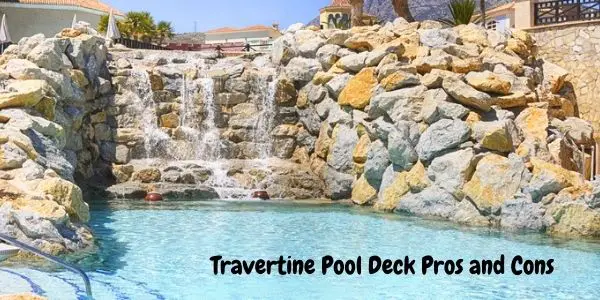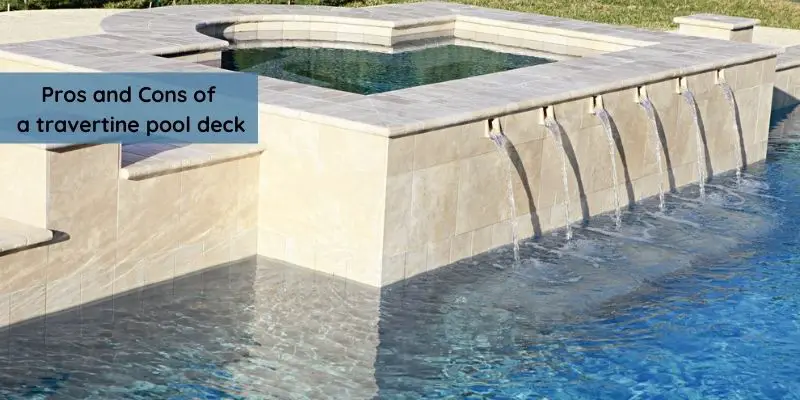Travertine Pool Deck Pros and Cons
Pool decking does enhance the aesthetic value and look of your swimming area, it can be made of concrete, tile, granite, sandstone, or even wood. However, for a naturally beautiful look, travertine is a great option to consider due to its safety, aesthetic, and durability benefits. But, what are the pros and cons of travertine pool decks?
Travertine creates natural non-slip floor decks around your pool. Its low maintenance, durable, heat resistant, and long-lasting(up to 100 years). However, it’s prone to acidic damage, requires a strong foundation, and needs occasional resealing to last longer.

Is travertine good for around pools?
Travertine is a great option around pool decks, it creates a rustic look-resistant to extreme temperature changes. Since it’s a natural stone, it absorbs water leaving it a less slippery pool deck. Travertine tiles are known to last up to 100 years when properly maintained.
Travertine is an elegant limestone material mined beneath the hot springs for thousands of years. As the water beneath the ground boils and shoots up, it sprinkles unique pits and characters on each stone. As is expected of natural stone tiles, travertine also undergoes quarrying, which majorly involves slicing to preferred sizes and shapes. With travertine tiles around your pool deck area, nothing creates a homely feel than when walking barefoot or sitting at the edge of your pool.
The idea behind using travertine for pool decks, walkways, and driveways is to provide a rustic look. You want your pool area to look natural with a touch of uniqueness. However, you can still play around with colors and any style that matches your needs. To ensure it doesn’t conform to wear and tear, ensure it’s sealed after installation. It also boasts of slip resistance properties, minimizing accidental risks around the pool.
Pros and Cons of a travertine pool deck
Travertine can create a natural look around your pool deck. You can choose from a variety of colors and shapes to create an original and attractive appearance in terms of decor. However, just like any other natural stone material, travertine has its benefits and problems too.

Here are the pros and cons of travertine tiles around pool decks:
The Pros
Here are some advantages of having travertine pool decks:
1. Travertine has a rustic aesthetic appearance
Travertine is a form of an all-natural stone, creating an earthy look to your pool deck. Adding color variations with unique styles can make your travertine pool deck look gorgeous, further accentuating your home or commercial property value.
The availability of a wide variety of styles and colors with travertine makes it a great option to install around pools in a modern home. Whether you are maximalist or minimalist, this natural stone allows you to explore as many styles as you can.
2. The tiles stay cool in hot weather
Travertine has a unique capillary network within its structure that allows for moisture and heat to transfer within the stone. During hot weather, the tiles do not get too hot under the feet.
The last thing anyone wants is walking or basking on a hot surface that could lead to skin burns. With travertine tile, you don’t have to worry about that. Its capillary action permits the low underground temperature to flow on the surface and reflect the sunlight.
Its insulation properties work best when you choose warmer colors, particularly if your home or commercial property experiences significantly higher temperatures during summer.
3. Travertine is low maintenance
Travertine tiles can be mounted even on uneven surfaces with irregular layouts. The tiles have straight edges and standard width, making installation an easy task of interlocking.
Maintaining a travertine pool deck is also easy; you can do it yourself because it is minimal. The tiles require regular sweeping and light cleaning with non-acidic detergents to get rid of any stubborn stains.
4. Highly durable decking tile
While the initial cost for a travertine pool deck may be expensive (costing $12.28 to $15.89 per square foot, labor included), you won’t have to worry about high maintenance costs as long as they’ve been installed and sealed properly. A well-installed travertine pool deck can last as long as 25-100 years.
5. It has a non-slip surface
Apart from absorbing water through its capillary network, travertine material has a better coefficient of friction compared to other types of decking material such as ceramic tiles. As such, it is a great non-sleep decking tile material to install around pools and pavements that get wet from time to time.
6. Travertine can be sealed to prevent efflorescence
Prolonged exposure to the sun and water makes building materials lose their original colors. A material that was initially white can turn brown or black over time when exposed to extreme environmental conditions. This occurs because of the migrating salt within the material – also called efflorescence.
Since efflorescence is a nuisance for outdoor decks around pools and even on pavements, especially when the tiles are exposed to water from splashes and rain, you can prevent it by applying an impregnating sealer.
The Cons
Here are the disadvantages of installing travertine pool decks:
1. Travertine reacts to acids
Travertine contains calcium carbonate, which can react when exposed to specific acids from building materials. If you notice your pool deck tiles starting to chip or break down, it could be a sign that acids are be etching or staining the surface.
To prevent your tiles from degradation or damage (whether sealed or unsealed), avoid cleaning products containing acids such as vinegar.
2. Travertine’s weight can impact a weaker foundation base
Natural stone is heavier than most building materials. If the foundation of your swimming pool sits on a weaker soil structure, it may not hold the weight of the stone so well.
To avoid extra costs due to poor installation, hire a qualified expert who knows how to correlate soil structure and foundation base and implement the best reinforcement strategies.
3. Travertine needs to be sealed
Unsealed travertine tiles are likely to succumb to wear and tear due to their porous nature. While you have the option of buying a cheaper sealing product, eventually, you will make up for the cost due to heightened maintenance costs. Since you don’t want to pay for hefty maintenance costs, it would be best to go for high-quality sealing products once and for all.
Is travertine more expensive than pavers?
Installing travertine pavers around a pool deck is more expensive compared to concrete pavers. The average cost of travertine is $15 per square foot and can go as high as $30 per sq. ft while concrete pavers cost between $2.50 and $7 per sq. ft.
Travertine is an all-natural stone, which is rare to get. Processing starts with quarrying from places where it can be unearthed, making it more expensive to obtain. After the installation, the sealing process also comes in, further increasing the cost.
However, the number of years it takes to enjoy the benefits and the unique look of travertine pool decking are what justify its initial cost.
Concrete pavers, on the other hand, are easy to come by since they are readily available. The main costs you’ll incur are cutting, installation, and routine maintenance. As far as repairs are concerned, a travertine pool deck will attract higher costs than a paver.
Whether you are a spendthrift or budget-conscious, your pool decking choices remain purely upon you. There is no set formula for choosing standard or luxurious pool deck materials. However, the best way to get value for your money and end up with what suits you is by weighing the pros and cons of every material.

